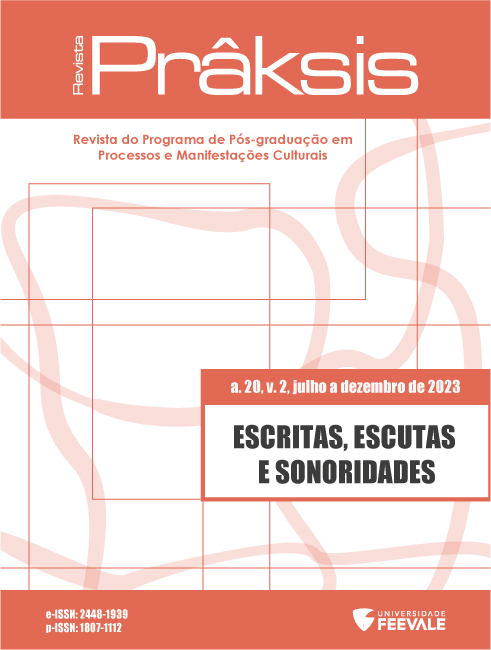VOCOBIOGRAFIA ESPECTRAL: ENCONTRO E ESCUTA EM HILDA HILST PEDE CONTATO
DOI:
https://doi.org/10.25112/rpr.v2.3421Abstract
The film Dead ones, do you live? (2018), by Gabriela Greeb, emerged from the filmmaker's encounter with an archive of over a hundred hours of recordings of the writer Hilda Hilst's voice, in which she tried to communicate with dead people through radio frequencies. Refusing a biographical bias, the film creates an audiovisual universe that seeks to converse with Hilda's poetic spirit. This article reflects on the treatment given to the acousmatic voice in the film, whose unique artistic procedures invite investigation. It proposes to think in what ways the film subverts historically calcified forms of depriving the word of any corporeality, notably of the materiality of the voice. We call spectral vocobiography the treatment given by the filmmaker to the voice archives of Hilst, with emphasis on what evolves in between presence and absence, individual and collective, fiction and reality.
References
REFERÊNCIAS
BEZERRA, A. G. Desdobramentos ficcionais de uma existência: a exposicão do eu autoficcional em Hilda Hilst. 2015. 168 f. Tese (Doutorado em “Literatura e Insterculturalidade”) – Universidade Estadual da Paraíba, Campina Grande, Paraíba, 2015.
CAVARERO, A. Vozes plurais: filosofia da expressão vocal. Tradução de Flavio Terrigno Barbeitas. Belo Horizonte: Editora UFMG, 2011. 312 p.
CHION, Michel. The voice in cinema. Tradução ao inglês de Claudia Gorbman. New York: Columbia University Press, 1999. 183 p.
SOBRENOME, N. S. Título do texto em meio eletrônico. Cidade: Editora, 2000. Disponível em: http://www.site.com.br. Acesso em: 8 jan. 2017.
CONNOR, S. Panophonia. Disponível em: www.stevenconnor.com/panophonia. Acesso em 20 jul. 2022.
DOLAR, M. Una voz y nada más. Tradução ao espanhol de Daniela Gutiérrez y Beatriz Vignoli. Buenos Aires: Manantial, 2007. 232 p.
DUARTE, Pedro. O elogiável risco de escrever sem ter fim. São Paulo: Folha de São Paulo, 2016. Disponível em: https://m.folha.uol.com.br/ilustrissima/2016/02/1743666-o-elogiavel-risco-de-escrever-sem-ter-fim.shtml. Acesso em 10 jul. 2019.
FRANÇA, A.; MACHADO, P. F.M. Rocha que voa: o cinema, a memória e o “teatro de operações” da montagem. Doc on-line, Campinas, n. 8, p. 132-148, ago. 2010.
GREEB, G. Hilda Hilst pede contato. São Paulo: Sesi-SP Editora, 2018. 240 p.
HILST, H.; DINIZ, C. (org.). Fico besta quando me entendem: entrevistas com Hilda Hilst. São Paulo: Globo, 2013. 240 p.
JÜRGENSON, F. Telefone para o Além. Rio de Janeiro: Civilização Brasileira, 1972. 250 p.
OBICI, G. L. Condição da escuta. 7Letras: 2008. 184 p.
SÜSSEKIND, F. Coro contra coros: a tecnopolítica parasitária & as formas geminadas de fabulação. Disponível em: https://aterraeredonda.com.br/coro-contra-coros-a-tecnopolitica-parasitaria-as-formas-geminadas-de-fabulacao/. Acesso em: 20 mar 2023.
TOOP, D. Resonancia Siniestra: el oyente como medium. Tradução ao espanhol de Valeria Meiller. Buenos Aires: Caja Negra, 2016. 320 p.
WRIGHT, S. Spectral Voices and Resonant Bodies in Fernando Guzzoni’s Dogflesh (Carne de perro, 2012). In: WHITTAKER, Tom; WRIGHT, Sarah (editores). Locating the voice in film: critical approaches and global practices. New York: Oxford University Press, 2017. p. 243-261.
Downloads
Published
How to Cite
Issue
Section
License
Copyright (c) 2023 Maria de Abreu Altberg

This work is licensed under a Creative Commons Attribution 4.0 International License.
• Os autores mantêm os direitos autorais e concedem à revista o direito de primeira publicação com o trabalho licenciado sob a Licença Creative Commons - Attribution 4.0 International (CC BY 4.0).
• Os autores são estimulados a publicar e distribuir seu trabalho online (ex.: em repositórios institucionais ou na sua página pessoal), pois isso pode aumentar o impacto e a citação do trabalho publicado.


